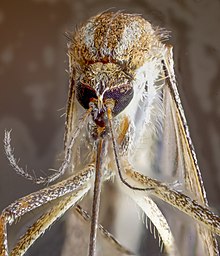Encyclopedia Dubuque
"Encyclopedia Dubuque is the online authority for all things Dubuque, written by the people who know the city best.”
Marshall Cohen—researcher and producer, CNN
Affiliated with the Local History Network of the State Historical Society of Iowa, and the Iowa Museum Association.
MOSQUITOES
MOSQUITOES. Mosquitoes (or mosquitos) are members of a group of almost 3,600 species of small flies within the family Culicidae (from the Latin culex meaning "gnat"). The word "mosquito" (formed by mosca and diminutive -ito) is Spanish for "little fly". Mosquitoes have a slender segmented body, one pair of wings, one pair of halteres, three pairs of long hair-like legs, and elongated mouthparts.
The mosquito life cycle consists of egg, larva, pupa, and adult stages. Eggs are laid on the water surface; they hatch into larvae that feed on aquatic algae and organic material. These larvae are important food sources for many freshwater animals, such as dragonfly nymphs, many fish, and some birds such as ducks. The adult females of most species have tube-like mouthparts (called a proboscis) that can pierce the skin of a host and feed on blood, which contains protein and iron needed to produce eggs. Thousands of mosquito species feed on the blood of various hosts — vertebrates, including mammals, birds, reptiles, amphibians, and some fish; along with some invertebrates, primarily other arthropods.
The mosquito's saliva is transferred to the host during the bite, and can cause an itchy rash. In addition, many species can ingest pathogens while biting, and transmit them to future hosts. In this way, mosquitoes are important spreaders of parasitic diseases such as malaria and filariasis, and arboviral diseases such as yellow fever, Chikungunya, WEST NILE VIRUS, dengue fever, and Zika. By transmitting diseases, mosquitoes cause the deaths of more people than any other animal taxon: over 700,000 each year. It has been claimed that almost half of the people who have ever lived have died of mosquito-vectored disease, but this claim is disputed, with more conservative estimates placing the death toll closer to 5% of all humans. Mosquitoes cannot live or function properly when the air temperature is below 10 degrees Celsius (50 degrees Fahrenheit). They are mostly active at 15–25 degrees Celsius (60–80 degrees Fahrenheit).(1)
Mosquitos are attracted by the heat radiating from human bodies, carbon dioxide exhaled in our breath, and sweet amino acids, especially one called lysine, mixed in our sweat. In 1903 women held "mosquito parties" with each in attendance holding an umbrella over which colored mosquito netting was hung to protect the guest. (2)
By 1903 various studies of mosquitoes had shown their growth as young insects in pools of water. Remedies to the problematic insect led to oil being released on the water's surface to prevent the young from escaping and/or draining pools of water to eliminate their use as breeding grounds. (3) Government scientists in 1972 claimed a major breakthrough in controlling the insect without DDT or other chemical pesticides. The answer, they claimed, lay in the use of a tiny parasitic nematode (worm) which bored holes in the mosquito larvae. The species Resimermis nielseni attacked only mosquitoes. Laboratory tests over a two-year period and reported in the May issue of Agricultural Research showed the worms infect 13 of 19 known kinds of mosquitos in Louisiana and had a 100% kill record. The worms usually only killed mosquitoes while they were in the larvae stage. (4) In 2002 homeowners were faced with devices priced from $200 to $1,300 for carbon dioxide-based machines such as the Mosquito Magnet and Mosquito Eradicator designed to attract and trap mosquitos. (5)
FLOODS (Record) and cool weather had a distinct relationship with the degree of problems associated with mosquitoes. In 1998 high water submerged areas of land in the Dubuque area. Health officials noted that temperatures in the low 70s would maintain the mosquito population at normal levels. If the weather remained cool while the water receded, the threat of more insets would also be lessened. Higher temperatures could lead to an increase in the number of cases of encephalitis which usually appeared after mid-July. People outside at dusk or later in the evening were cautioned to wear clothing with sleeves, pants, and use an insect repellent. (6)
Cool weather, however, was not entirely a safeguard against all species of mosquitoes. In August of 2004 unseasonably cool temperatures during the summer led Dubuque health officials to trap only 338 mosquitoes between July 31st and August 6th. This compared to 1,194 during the same period in 2003. The number of culex mosquitoes, the kind that carried West Nile virus, did not reflect the same sharp decline with 50 being trapped compared to 55 the previous year. (7)
See:
---
Source:
1. "Mosquito," Wikipedia, Online: https://en.wikipedia.org/wiki/Mosquito
2. "The Mosquito Party and How It is Given," Dubuque Telegraph-Herald, August 9, 1903, p. 15
3. "Fighting the Mosquito Plague," Dubuque Telegraph-Herald, August 2, 1903, p. 6
4. "Means to Control Disease-bearing Mosquitoes Found," Telegraph Herald, May 14 1972, p. 9
5. Mullekom, Kathy Van, "Buzz," Telegraph Herald, August 6, 2002, p. 1
6. Carlisle, Nathan, "Conditions Point to a Flood of Mosquitos," Telegraph Herald, May 27, 1999, p. 1
7. Hogstrom, Erik, "West Nile Cases Drop," Telegraph Herald, August 19, 2004, p. 1


